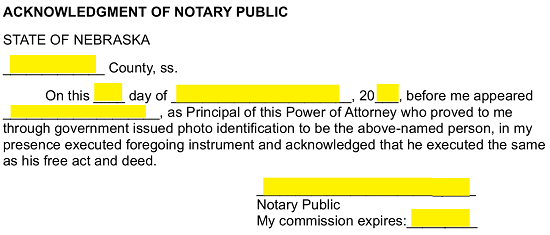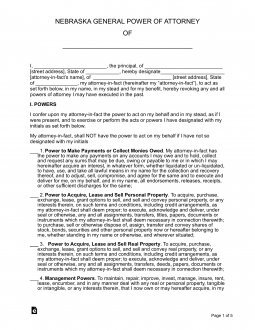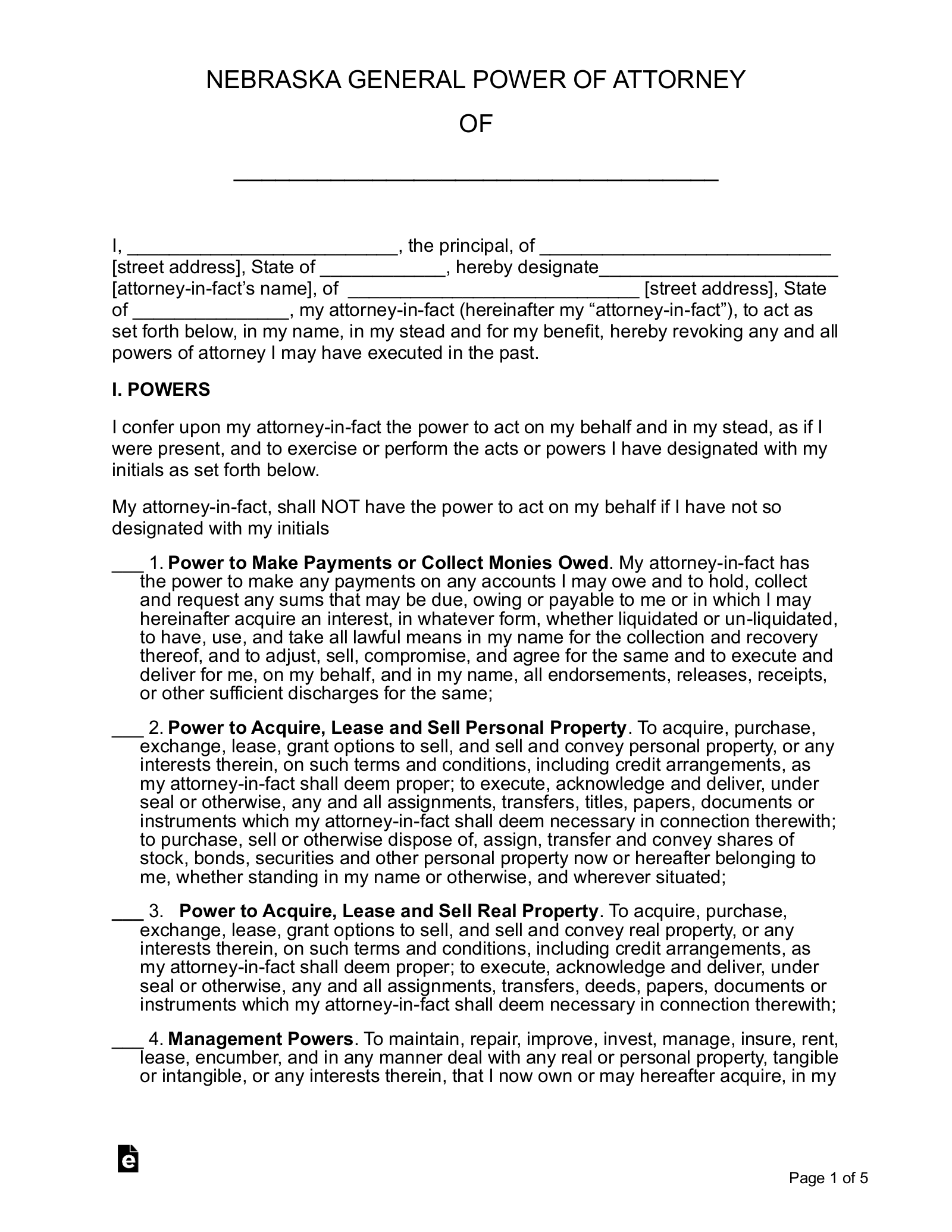Updated August 09, 2023
A Nebraska general (financial) power of attorney form is a document that allows you to appoint your spouse, a relative, a friend, or a qualified professional as your agent to manage your property and assets. This type of delegation becomes void upon your incapacity or inability to make decisions on your own behalf as determined by a physician. Some may consider this option as security against an agent acting without the Principal’s instructions. That is if the Principal is rendered unable to function the Agent’s power automatically terminates. If you are looking for something that continues in effect, you should look at the durable power of attorney instead.
Laws
- Statutes – Nebraska Uniform Power of Attorney Act (§§ 30-4001 — 30-4045)
- Authority (Neb.Rev.St. § 30-4024) – An agent under a power of attorney may act on behalf of the principal and exercise broad authority as granted by the agreement.
- Signing Requirements (Neb. Rev. St. § 30-4005) – Required to be signed in the presence of a notary public.
How to Write
Download: PDF, MS Word, OpenDocument
1 – This Document’s Title And Introduction Need To Be Supplied With information
You must record the Full Name (First Name, Middle Name, Last Name) of the Principal who is delegating Authority to an Attorney-in-Fact in the Title at the top of the page. Now, on the first blank space in the introduction, enter the Principal’s Legal Name exactly as it was recorded on the blank line in the Title.
Now, on the first blank space in the introduction, enter the Principal’s Legal Name exactly as it was recorded on the blank line in the Title.
Next, we will document the Physical Location of the Principal. This action will be completed using the two empty spaces after the words “…the Principal, Of.” On the space preceding the bracketed designation, “Street Address,” supply the Building Number, Street, Suite Number, and the City/County where the Principal maintains his or her Residence. This should be followed with the Name of the State where the Principal resides. Lastly, a report on who the Principal is appointing Principal Authority to must be made. You must use the three blank spaces after the words “…Hereby Designate” to accomplish this goal. Enter the First, Middle, and Last Name of the Attorney-in-Fact (Principal’s Agent) on the empty line preceding the label “Attorney-in-Fact’s Name.”
Lastly, a report on who the Principal is appointing Principal Authority to must be made. You must use the three blank spaces after the words “…Hereby Designate” to accomplish this goal. Enter the First, Middle, and Last Name of the Attorney-in-Fact (Principal’s Agent) on the empty line preceding the label “Attorney-in-Fact’s Name.” After entering the Attorney-in-Fact’s Name, record the Building Number, Street Name, Suite Number, and City where the Attorney-in-Fact maintains an active Residence. The final space shall require the State where the Attorney-in-Fact’s Residence is located.
After entering the Attorney-in-Fact’s Name, record the Building Number, Street Name, Suite Number, and City where the Attorney-in-Fact maintains an active Residence. The final space shall require the State where the Attorney-in-Fact’s Residence is located.
2 – Article I Provides A List Of Principal Powers The Principal Must Personally Approve
The first section on this page is Article “I. Powers” is a list that is composed of various Subjects of Authority. The Principal should read through this list, making sure to comprehend each definition, then initial the blank lines appropriate to the Subject Definition of Principal Powers he or she wishes to grant to the Attorney-in-Fact.
The first Subject Definition is labeled “Power To Make Payments Or Collect Monies Owed.” If the Principal has decided to empower the Agent with the Principal Power to conduct any of the actions listed in the paragraph, then he or she must initial the blank line just before the Number 1.
The Principal Authority to empower the Agent with the ability to act on the Principal’s Personal Property will be granted to the Attorney-in-Fact when the Principal initials the blank space corresponding to the paragraph statement labeled “Power TO Acquire, Lease, And Sell Personal Property” If the Principal also wants to deliver the Principal Authority the Attorney-in-Fact requires to affect his or her Real Property, the Principal should initial the paragraph labeled “Power To Acquire Lease And Sell Real Property”
If the Principal also wants to deliver the Principal Authority the Attorney-in-Fact requires to affect his or her Real Property, the Principal should initial the paragraph labeled “Power To Acquire Lease And Sell Real Property” The Attorney-in-Fact will have access to the same “Management Powers” as those of the Principal (as defined in this paragraph item) when the Principal initials blank line preceding the Number 4.
The Attorney-in-Fact will have access to the same “Management Powers” as those of the Principal (as defined in this paragraph item) when the Principal initials blank line preceding the Number 4. The Subject Definition in the fifth paragraph item, “Banking Powers,” provides the language required to deliver Principal Authority when dealing with Financial Institutions (on behalf of the Principal). If the Principal has decided to grant this Power to the Agent, then he or she will need to initial the fifth paragraph.
The Subject Definition in the fifth paragraph item, “Banking Powers,” provides the language required to deliver Principal Authority when dealing with Financial Institutions (on behalf of the Principal). If the Principal has decided to grant this Power to the Agent, then he or she will need to initial the fifth paragraph.  The Principal can empower the Attorney-in-Fact to act on his or her behalf with “Motor Vehicles” by initialing the blank space just before the Number 6.
The Principal can empower the Attorney-in-Fact to act on his or her behalf with “Motor Vehicles” by initialing the blank space just before the Number 6.  If the Principal intends to grant “Tax Powers” to the Attorney-in-Fact, as described in the Subject Definition, then he or she must initial the seventh paragraph.
If the Principal intends to grant “Tax Powers” to the Attorney-in-Fact, as described in the Subject Definition, then he or she must initial the seventh paragraph. 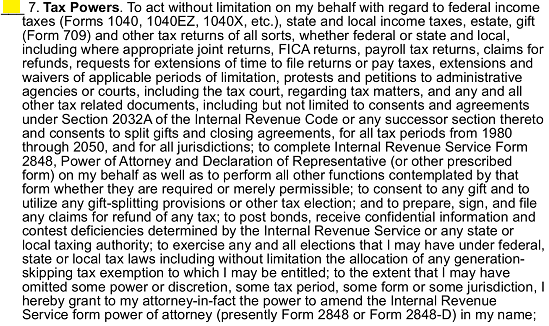 The Attorney-in-Fact will be appointed with the Principal Power to access and effect the Principal’s “Safe-Deposit Boxes,” if the Principal initials the eighth item.
The Attorney-in-Fact will be appointed with the Principal Power to access and effect the Principal’s “Safe-Deposit Boxes,” if the Principal initials the eighth item.  The Principal’s “Gift Making Powers” can be delivered to the Attorney-in-Fact through the wording in the ninth paragraph definition. The Principal will empower the Agent in this matter by initialing the blank space just before the Number 9.
The Principal’s “Gift Making Powers” can be delivered to the Attorney-in-Fact through the wording in the ninth paragraph definition. The Principal will empower the Agent in this matter by initialing the blank space just before the Number 9.
The same Powers the Principal has regarding “Lending And Borrowing” will be delegated to the Agent if the Principal initials the tenth Subject Definition.  If the Attorney-in-Fact should have the Principal Authority to make decisions and act regarding “Contracts” in the Name of the Principal, then initial the blank space before the Number 11.
If the Attorney-in-Fact should have the Principal Authority to make decisions and act regarding “Contracts” in the Name of the Principal, then initial the blank space before the Number 11. ![]() The Attorney-in-Fact can make the Principal “Health Care” decisions described in the twelfth Subject Definition when the Principal initials the blank space preceding the Number 12.
The Attorney-in-Fact can make the Principal “Health Care” decisions described in the twelfth Subject Definition when the Principal initials the blank space preceding the Number 12.  The Principal can name the Attorney-in-Fact as his or her Representative under the Health And Insurance Portability And Accountability Act Of 1996 by initial the Subject Definition labeled “HIPAA”
The Principal can name the Attorney-in-Fact as his or her Representative under the Health And Insurance Portability And Accountability Act Of 1996 by initial the Subject Definition labeled “HIPAA”![]() The Principal “Power To Hire And Pay For Services” in the Name of the Principal will be delivered to the Attorney-in-Fact through the wording in paragraph Number 14. The Principal can grant this Power to the Attorney-in-Fact by initialing the fourteenth item.
The Principal “Power To Hire And Pay For Services” in the Name of the Principal will be delivered to the Attorney-in-Fact through the wording in paragraph Number 14. The Principal can grant this Power to the Attorney-in-Fact by initialing the fourteenth item.  The Principal can delegate Principal Power over the “Reimbursement Of Attorney-in-Fact” to the Attorney-in-Fact by initialing the fifteenth Subject Definition.
The Principal can delegate Principal Power over the “Reimbursement Of Attorney-in-Fact” to the Attorney-in-Fact by initialing the fifteenth Subject Definition. ![]() If the Principal desires the Attorney-in-Fact to have the “Power To Sue Third Parties Who Fail To Act Pursuant To Power Of Attorney” with Principal Authority, then he or she must initial the space just before the Number 16.
If the Principal desires the Attorney-in-Fact to have the “Power To Sue Third Parties Who Fail To Act Pursuant To Power Of Attorney” with Principal Authority, then he or she must initial the space just before the Number 16.  Several blank lines have been provided in the item labeled as “Other.” If the Principal wishes to grant additional Principal Powers or extensions to the Powers defined above, then he or she should make these preferences known using these blank lines. The Principal should initial this item once his or her Instructions, Preferences, and/or Provisions have been successfully reported.
Several blank lines have been provided in the item labeled as “Other.” If the Principal wishes to grant additional Principal Powers or extensions to the Powers defined above, then he or she should make these preferences known using these blank lines. The Principal should initial this item once his or her Instructions, Preferences, and/or Provisions have been successfully reported. 
3 – Article III Delivers The Instrument To Name The Effective Dates Of This Delegation
In order for the Attorney-in-Fact to effectively wield the Power in this document, this paperwork will need to provide a specific time span when the Principal Authority is active and accessible to the Attorney-in-Fact. We can reach this goal by having the Principal choose one of the first two statements to define the Start Date of the Attorney-in-Fact’s Principal Powers then choosing one of the last three statements to define the Attorney-in-Fact’s Termination Date.
The Principal may elect to have the Powers in this form delivered to the Attorney-in-Fact immediately upon the Principal Signing. If so, the Principal will need to initial the first statement.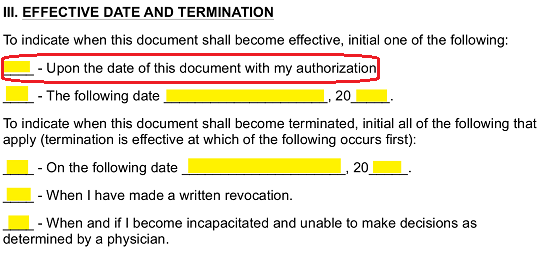
If the Principal prefers to set these Powers as active only on a specific Date, then he or she should initial the second statement and provide this desired Date of Effect on the three blank spaces supplied in this statement. 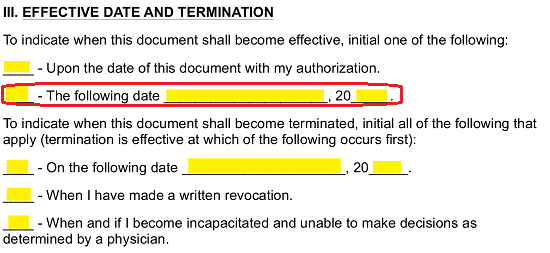 Once the Principal has determined the Starting Date of these Powers, he or she will need to set the Termination Date or Event as well. If the Principal wishes to set a specific Date of Termination for these Powers then he or she must initial the first statement, in the second area of this article, and supply the Date of Termination using the spaces provided.
Once the Principal has determined the Starting Date of these Powers, he or she will need to set the Termination Date or Event as well. If the Principal wishes to set a specific Date of Termination for these Powers then he or she must initial the first statement, in the second area of this article, and supply the Date of Termination using the spaces provided. 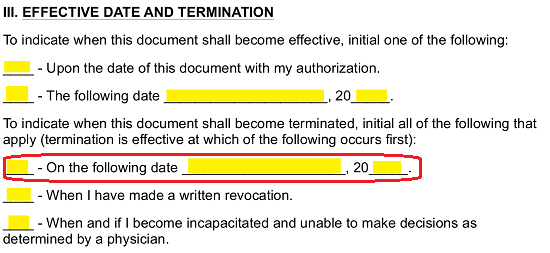 The Principal can also make this a Durable issue of Power by, terminating only upon his or her written Revocation, by initialing the second statement in this area.
The Principal can also make this a Durable issue of Power by, terminating only upon his or her written Revocation, by initialing the second statement in this area. 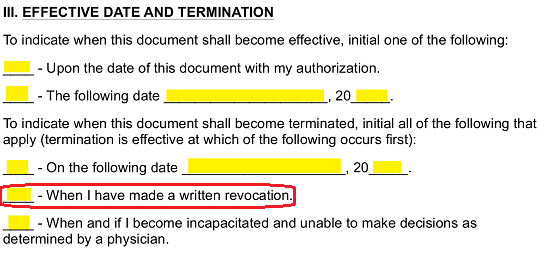 If the Principal wishes this Authority to remain in effect only so long as he or she can make his or her own decisions then he or she should initial the third statement here. This will mean that if a Physician has issued a written diagnosis that the Principal has been rendered incapacitated, these Powers will automatically terminate.
If the Principal wishes this Authority to remain in effect only so long as he or she can make his or her own decisions then he or she should initial the third statement here. This will mean that if a Physician has issued a written diagnosis that the Principal has been rendered incapacitated, these Powers will automatically terminate.
4 – Article IV Must Be Signed By The Principal
The Principal must supply the Date he or she is executing these Powers by filling in the Day, Month, and Year of signing using the three blank spaces in the final statement of this article. The Principal must sign this form on the indicated Date of Signature above. He or she should supply the Principal Signature on the “Principal’s Signature” line along with his or her Printed Name on the “Principal’s Printed Name” line.
The Principal must sign this form on the indicated Date of Signature above. He or she should supply the Principal Signature on the “Principal’s Signature” line along with his or her Printed Name on the “Principal’s Printed Name” line.
5 – The Attorney-in-Fact and Notary Public Must Validate This Form
The Primary Agent or Attorney-in-Fact named in this form will need to verify his or her Acceptance of the Power Appointment here. Locate the “Acceptance Of Appointment” area, then enter the Attorney-in-Fact’s Full Name on the blank line in this statement. Once the Attorney-in-Fact has reviewed this document and the “Acceptance of Appointment” Statement, he or she must sign and print his or her Name on the blank spaces labeled “Attorney-in-Fact’s Signature” and “Attorney-in-Fact’s Printed Name” (respectively).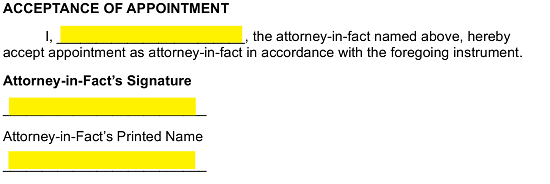
The final substantiating party will be the Notary Public. The Notary Public will have a procedure set in place so that he or she can notarize the Principal Signing of this form. This will require the Notary Public to fill in the Location, the Date, and the individuals present at Signing then, supplying his or her credentials and seal.